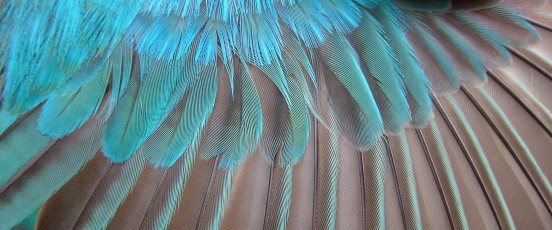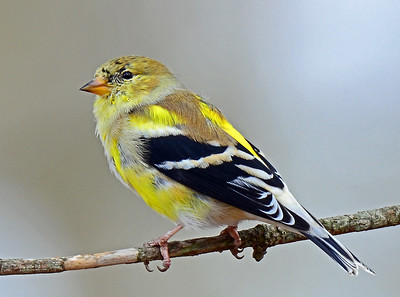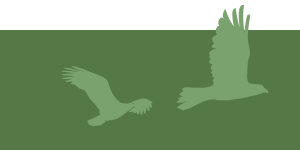
MOLT AND PLUMAGE STUDIES

Molt is an essential, but costly, process in a bird's life cycle that is worthy of greater study. Replacing feathers requires a lot of energy; annual molt can require a quarter or more of a bird’s total body protein mass, much of which comes from muscle tissue. Feather loss also makes a bird vulnerable to heat loss and predators. The high energy demands of molt make it incompatible with other energetically demanding activities like breeding or migration.
IBP researchers work with scientists all over the world to study live birds and museum specimens. We are interested in molt strategies of birds, how to name molts and plumages, and how molts have evolved from reptiles to ancestral birds to modern-day birds.
Now available!

The second Edition of Part 1 of IBP biologist Peter Pyle's Identification to North American Birds (2022) is now available from Slate Creek Press. This updated version, produced as a collaboration between Slate Creek Press and The Institute for Bird Populations, includes revised and consistent molt and plumage terminology, "WRP" age and plumage codes, the addition of 21 new species accounts, presentation of measurements in tables for greater ease of comparison, and added values for exposed culmen, tarsus, and mass. Fifteen new figures have been added and Information has been substantially revised through evaluation of digital images, comments received from hundreds of users since 1997, and the incorporation of over 1,295 additional scientific papers and on-line resources. See SlateCreekPress.com for more details and ordering information!
In addition, Literature Cited is now available in PDF form for both the revised Part 1 and for Part 2, and an Errata Sheet has been created for the revised Part 1 and will be updated as needed.
Video Links
For more information about our work with molt and plumage, contact Peter Pyle.
CONSERVATION IMPLICATIONS
Molt is so demanding that some species actually migrate to different habitats to undergo the process- this is called "molt migration." In 2018, IBP scientists found evidence that molt migration is more common than previously thought. Many songbirds previously were thought to molt on their breeding grounds, prior to migration. And for many years, the phenomenon of molt migration was thought to occur in just a handful of species.
Our IBP team found evidence that most North American landbirds at least sometimes migrate or disperse to areas separate from the breeding or wintering grounds to molt. This includes species like American Goldfinch; House, Carolina and Pacific wrens; Gray Catbird and Northern Cardinal.

Why move to molt? The most likely explanation is food resources (although this hypothesis has not yet been tested rigorously). Birds breed in areas where food is abundant early in the summer, when they are courting, laying eggs and feeding chicks. Towards the end of the summer, food resources (like insects) may decrease in these habitats, but increase in others. Birds are very mobile creatures, so they can move to areas where there is plenty of food to fuel the growth of new feathers.
Conserving birds requires understanding their needs across their entire lifecycle. Molt is an important part of that lifecycle and protecting the habitat where birds undergo molt will help conserve populations.
For more information see our papers on this:
Molting American Goldfinch photo by Rodney Campbell/Flickr.
SELECTED PUBLICATIONS
Peer-reviewed Publications Authored by IBP Personnel
Guallar, S., A. Ruiz-Sánchez, R. Rueda-Hernández, and P. Pyle. 2025. Median-crown stripe variation in two ant-tanagers (Cardinalidae). Ornithology Research 38:18. PDF
Pyle, P. 2025. Featured photo: use of environmental context in bird identification. Birding March 2025:58-61. PDF
Stewart, M.T., B.A. Millsap, P. Pyle, A.M. Tanner. 2025. Systematic Review of Age at First Breeding in Diurnal Raptors of the United States and Canada. Journal of Raptor Research. 59(4):jrr2542. PDF
Kiat, Y., and P. Pyle. 2024. Recent changes in distribution and plumage phenologies of the White?winged Tern (Chlidonias leucopterus) in the Middle East. Journal of Ornithology 126. Published online 18 August 2024. PDF
Pyle, P. 2024. Guía de Identificación de Aves de América del Norte, Parte I, Tomo I. R. Rueda-Hernández, M. Albornoz, C. Gigena, V. and S. Guallar, Translators. Ecoval Ediciones, México.
Pyle, P., and L. Schofield. 2023. Molting strategies of sapsuckers (Sphyrapicus): effects of migration distance and age through the fourth and later plumage cycles. The Wilson Journal of Ornithology 135:445-456. PDF
Pyle, P., S.N.G. Howell, D.I. Rogers, and C. Corben. 2024. Moult terminology: envisioning an evolutionary approach. Journal of Avian Biology 2024:e03169. PDF
Rueda-Hernandez, R., Guallar, S. and P. Pyle. 2023. Preformative molt extent of Cardellina warblers increases with breeding latitude and migration distance. The Wilson Journal of Ornithology 135:000-000. PDF
Sieburth, D.E., R. Terrill, and P. Pyle. 2023. The potential identification and distribution of Ainley's Storm-Petrel at sea by timing of molt. Western Birds 54:133-143. PDF
Stewart, M.T., P. Pyle, and W.S. Clark. 2023. Molt and body measurements for Gray Hawks in the Lower Rio Grande Valley of Texas. Journal of Field Ornithology 94:10. PDF
Hudon, J., and P. Pyle. 2022. Diet-related plumage erythrism in the Western Tanager and other western North American Birds. Western Birds 53:30-42. PDF
Pyle, P. 2022. Defining moults in migratory birds: a sequence-based approach. Journal of Avian Biology 5:1-9. PDF
Pyle, P. 2022. Examination of digital images from Macaulay Library to determine avian molt strategies: a case study on molts and plumages in eight species of North American hummingbirds. The Wilson Journal of Ornithology 134:52-65. PDF
Pyle, P. 2022. Examination of digital images from Macaulay Library to determine avian molt strategies: a case study on molts and plumages in eight species of North American hummingbirds. Supplemental Material, including a full primer on ageing hummingbirds. Wilson Journal of Ornithology 134:52-65. PDF
Pyle, P. 2022. Identification Guide to North American Birds, Part 1, 2nd Edition. Slate Creek Press, Forest Knolls, California. 698 pp.
Pyle, P., and B. H. Carnes. 2022. Molt strategies by age and subspecies in the Willow Flycatcher. Western Birds 53:216-231. PDF
Pyle, P., M. Gahbauer, E.I. Johnson, T.B. Ryder, and J.D. Wolfe. 2022. Application of a global age-coding system (WRP), based on molts and plumages, for use in demographic and other studies of birds. Ornithology 139:1-12. PDF
Carnes, B.H., C.M. Godwin, K.R. Foster, and P. Pyle. 2021. Clarification of molt strategies in three Empidonax flycatchers. The Wilson Journal of Ornithology 133:34-42. PDF
Floyd, H., and P. Pyle. 2021. Variation in winter dowitchers. Birding 52(8):48-58. PDF
Guallar, S., R. Rueda-Hernandez, and P. Pyle. 2021. Evolution of the preformative molt in Cardinalidae correlates with transitions from forest to open habitats. Ornithology 138:1-14. PDF
Kiat, Y., P. Pyle, A. Balaban, and J.K. O’Connor. 2021. Reinterpretation of purported molting evidence in the Thermopolis Archaeopteryx. Communications Biology 4:837. PDF
Moisan Perrier, J., D. Kneeshaw, M.H. St.-Laurent, P. Pyle, and M.A. Villard. 2021. Budworm-linked warblers as early indicators of defoliation by spruce budworm: a field study. Ecological Indicators 125:107543. PDF
Nicholson, R., and P. Pyle. 2021. Analyzing molts and plumages with digital images. Birding 52(2):58-63. PDF
Pyle, P. 2021. The plumages of the Pileated Woodpecker. Birding 52(8):26-33. PDF
Floyd, T., and P. Pyle. 2020. In praise of the rectrix: feather birding with a point-and-shoot. Birding 53(4):42-45. PDF
Pyle, P. 2020. A Black White Noddy. Birding 52(2):59-60. PDF
Pyle, P. 2020. Aging and sexing Cedar Waxwings. Birding 52(1):22-23. PDF
Pyle, P. 2020. Molt, age, and identification of the Masked and Nazca Boobies in California. Western Birds 51:129-149. PDF
Pyle, P. 2020. The molts and plumages of the Bobolink. Birding 52(1):61-62. Second in a two-part article with Rick Wright. PDF
Pyle, P., K.R. Foster, C.M. Godwin, D.R. Kaschube, and J.F. Saracco. 2020. Yearling proportion correlates with habitat structure in a boreal forest landbird community. PeerJ 8:e8898. PDF
Pyle, P. 2019. Book Review: E.I. Johnson and J.D. Wolfe. 2018. La Muda en Las Aves Tropicales [Molt in Neotropical Birds]. A publication of the American Ornithological Society, Volume 51. CRC Press, Boca Raton, FL. Hornero 33:72-74. PDF
Pyle, P. 2019. Sunset Sanderlings: Digital photography leads to novel insights about the presupplemental molt of the Sanderling. Birding 51(4) 30-41. PDF
Guallar, S., A. Ruiz-Sanchez, R. Rueda-Hernandez, and P. Pyle. 2018. Preformative wing molt in 23 Neotropical resident passerine species. Ornitología Neotropical 29:S3-10. PDF
Izaguirre, F., and P. Pyle. 2018. Electric Blue in the Bayou: the mystery of the Beaumont Cattle Egret. Birding 50(3):60-62. PDF
Pyle, P. 2018. Book Review: E.I. Johnson and J.D. Wolfe. Molt in Neotropical Birds: Life History and Aging Criteria. A Publication of the American Ornithological Society, Volume 51. CRC Press, Boca Raton, FL. Journal of Field Ornithology 89:105-107. PDF
Pyle, P., A. Ayyash, and M.B. Bartosik. 2018. Replacement of primaries during prealternate molts in North American Larus gulls. Western Birds 49:293-306. PDF
Pyle, P., J.F. Saracco, and D.F. DeSante. 2018. Evidence of widespread movements from breeding to molting grounds by North American landbirds. The Auk: Ornithological Advances 135:506-520. PDF
Rueda-Hernandez, R., S. Guallar, A. Ruiz-Sanchez, and P. Pyle. 2018. The molt issue: where do we go from now? Ornitología Neotropical 29:S1-S2. PDF
Sieburth, D., and P. Pyle. 2018. Evidence for a prealternate molt-migration in the Rufous Hummingbird and its implications for the evolution of molts in Apodiformes. The Auk: Ornithological Advances 135:495-505. PDF
Tanaka, T., and P. Pyle. 2018. An odd duck: sex, age, and Wood Ducks. Birding 50(5):58-61. PDF
van Bemmelen, R.S.A., R.H. Clarke, P. Pyle, and K. Camphuysen. 2018. Timing and duration of primary molt in Northern Hemisphere skuas and jaegers. The Auk: Ornithological Advances 135:1043-1054. PDF
Musher, L.J., P. Pyle, D.S. Irons, and J.R. Tietz. 2017. Identification of male Euphagus blackbirds in fresh fall plumage. Western Birds 48:205-2010. PDF
Pyle, P., and M. McPherson. 2017. Why so many white Eared Grebes?: possible interactions among leucism, molt, and pollutants. Birding 49(10):58-65. PDF
Pyle, P., K. Kayano, K. Tranquillo, K. Murphy, B. Wilcox, and N. Arcilla. 2017. Manual for ageing and sexing landbirds of American Samoa, with notes on molt and breeding seasonality. The Institute for Bird Populations, Point Reyes Station, CA. PDF
Guallar, S.X., A. Ruiz-Sanchez, R. Rueda-Hernandez, and P. Pyle. 2016. Molt strategies of ten Neotropical passerine species. The Wilson Journal of Ornithology 128:543-555. PDF
Nordell, C.J., S. Haché, E.M. Bayne, P.M. Sólymos, K.R. Foster, C.M. Godwin, R. Krikun, P. Pyle, and K.A. Hobson. 2016. Within-site variation in feather stable hydrogen isotope (δ2Hf) values of boreal songbirds: implications for assignment to molt origin. PLoS ONE 11:e0163957. (For a copy of this publication, please contact Peter Pyle.)
Pyle, P. 2016. Secondary aging criteria. Birding 48(2):28-32. PDF
Pyle, P., and M. Reid. 2016. Molts and plumages in Long-tailed and other jaegers: an "alternate" explanation for nonbreeding plumages? Western Birds 47:242-257. PDF
Pyle, P., D.L. Webster, and R.W. Baird. 2016. White-rumped dark storm-petrels in Hawaiian Island waters: the quandary of Leach's vs. Band-rumped storm-petrels throughout the world. Birding 48(1):58-73. PDF
Pyle, P., K. Tranquillo, K. Kayano, and N. Arcilla. 2016. Molt patterns, age criteria, and molt-breeding dynamics in American Samoan landbirds. The Wilson Journal of Ornithology 128:56-69. PDF
Siegel, R.B., M.W. Tingley, R.L. Wilkerson, C.A. Howell, M. Johnson, and P. Pyle. 2016. Age structure of Black-backed Woodpecker populations in burned forests. The Auk: Ornithological Advances 133:69-78. PDF
Clark, W.S., and P. Pyle. 2015. A recommendation for standardized age-sex class plumage terminology for raptors. The Journal of Raptor Research 49:513-517. PDF
Howell, S.N.G., and P. Pyle. 2015. Use of "definitive" and other terms in molt nomenclature: a response to Wolfe et al. The Auk: Ornithological Advances 132:365–369. PDF
Pyle, P., A. Engilis Jr., and D.A. Kelt. 2015. Manual for ageing and sexing landbirds of Bosque Fray Jorge National Park and north-central Chile, with notes on occurrence and breeding seasonality. Special Publications of the Louisiana State University. PDF
Pyle, P., A. Engilis Jr., and D.A. Kelt. 2015. Manual para estimar edad y sexo en aves del Parque Nacional Bosque Fray Jorge y Chile Central, con notas sobre rangos de distribucion y estacion reproductiva. Special Publications of the Louisiana State University. PDF
Pyle, P., C.M. Godwin, and K.R. Foster. 2015. Identifying juvenile warblers: The fun really begins here. Birding 47(6):58-69. PDF
Pyle, P., R.J. Keiffer, J.L. Dunn, and N. Moores. 2015. The Mendocino shrike: Red-backed Shrike (Lanius collurio) x Turkestan Shrike (L. phoenicuroides) hybrid. North American Birds 69:4-35. PDF
Sealy, S.G., P. Pyle, and H.R. Carter. 2015. Ancient Murrelets molt flight feathers after the precocial young become independent. The Northwestern Naturalist 96:212-221. PDF
Guallar, S., A. Ruiz-Sanchez, R. Rueda-Hernandez, and P. Pyle. 2014. Moult topography and its application to the study of partial wing-moult in two neotropical wrens. Ibis 156:311-320. PDF
McKee, T., P. Pyle, and N. Moores. 2014. Vagrancy and identification in first cycle Slaty-backed Gulls. Birding 46:38-51 plus 51A-J. PDF
Pyle, P. 2014. Plumages of second-basic and older Northern Harriers: a circular Circus? Birding 46:46-53. PDF
Rutt, C.L., P. Pyle, P.W. Collins, M.L. Brady, J.R. Tietz, and J.L. Dunn. 2014. The nominate subspecies of the Purple Finch in California and western North America. Western Birds 45:284-295. PDF
Nelson, K., and P. Pyle. 2013. Distribution and movement patterns of individual Crested Caracaras in California. Western Birds 44:45-55. PDF
Pyle, P. 2013. Dark-faced Common Murres off California in fall and winter. Western Birds 44:250-261. PDF
Pyle, P. 2013. Evolutionary implications of synapomorphic wing-molt sequences among falcons (Falconidae) and parrots (Psittaciformes). The Condor 115:593-602. PDF
Pyle, P. 2013. Harrier molts and plumages. Birding 45(4):10-12. PDF
Pyle, P. 2013. Molt homologies in ducks and other birds: a response to Hawkins (2011) and further thoughts on molt terminology in ducks. Waterbirds 36:75-79. PDF
Junda, J., A.L. Crary, and P. Pyle. 2012. Two modes of primary replacement during prebasic molt of Rufous Fantails (Rhipidura rufifrons). The Wilson Journal of Ornithology 124:680-685. PDF
Ruiz-Sanchez, A., R. Rueda-Hernandez, S. Guallar, and P. Pyle. 2012. Age determination of the Spot-breasted Wren and the White-breasted Wood-Wren using molt limits. North American Bird Bander 37:93-100. PDF
Wolfe, J.D., and P. Pyle. 2012. Progress in our understanding of molt patterns in Central American and Caribbean landbirds. In: Proceedings of the IX Neotropical Ornithological Congress-Peru. Ornitologia Neotropical 23:153-158. PDF
Wolfe, J.D., T.B. Ryder, P. Pyle, and E.I. Johnson. 2012. Using molt and plumage cycles to age tropical birds: updates and recent advances. Ornitologia Neotropical 23:153-158. PDF
Chambers, M., G. David, C. Ray, B. Leitner, and P. Pyle. 2011. Habitats and conservation of molt migrant birds in southeastern Arizona. The Southwestern Naturalist 56:204-211. PDF
De la Hera, I., D.F. DeSante, and B. Mila. 2011. Feather growth rate and mass in Nearctic passerines with variable migratory behavior and molt pattern. The Auk 129:222-230. PDF
Johnson, E.I., J.D. Wolfe, T.B. Ryder, and P. Pyle. 2011. Modifications to a molt-based ageing system proposed by Wolfe et al. (2010). Journal of Field Ornithology 82:422-424. PDF
Pyle, P. 2011. Book review: Guallar et al., Paseriformes del Occidente de Mexico: morfometria, datacion y sexado. Revista Catalana d'Ornitologia 27:45-47. (Catalan Version) PDF
Pyle, P. 2011. Book review: Guallar et al., Paseriformes del Occidente de Mexico: morfometria, datacion y sexado. Western Birds 42:120-122. (English Version) PDF
Pyle, P. 2011. Nomenclature of the Laysan Honeycreeper, Himatione [sanguinea] fraithii. The Bulletin of the British Ornithological Club 131:116-117. PDF
Radley, P., A.L. Crary, J. Bradley, C. Carter, and P. Pyle. 2011. Molt patterns, biometrics, and age and gender classification of landbirds on Saipan, Northern Mariana Islands. The Wilson Journal of Ornithology 123:588-594. PDF
Wolfe, J.D., and P. Pyle. 2011. First evidence for eccentric prealternate molt in the Indigo Bunting (Passerina cyanea): possible implications for adaptive molt strategies. Western Birds 42:257-262. PDF
Chandler, R.M., P. Pyle, M.E. Flannery, D.J. Long, and S.G. Howell. 2010. Flight feather molt of Turkey Vultures. The Wilson Journal of Ornithology 122:354-360. PDF
Pyle, P., and B.L. Sullivan. 2010. Documenting repeated occurrence of individual birds with digital images. Western Birds: 41:261-265. PDF
Pyle, P., and R. Kayhart. 2010. Replacement of primaries during the prealternate molt of a Yellow Warbler. North American Bird Bander 35:178-181. PDF
Wolfe, J.D., T.B. Ryder, and P. Pyle. 2010. Using molt cycles to categorize the age of tropical birds: an integrative new system. Journal of Field Ornithology 81:186-194. PDF
Froehlich, D. 2009. Ageing North American landbirds by molt limits and plumage criteria: a photographic companion guide to the Identification Guide to North American Birds, Part I. Slate Creek Press, Bolinas, CA. PDF
Pyle, P. 2009. Age determination and molt strategies in North American alcids. Marine Ornithology 37:219-225. PDF
Pyle, P., W.A. Leitner, L. Lozano-Angulo, F. Avilez-Teran, H. Swanson, E. Gomez-Limon, and M.K. Chambers. 2009. Temporal, spatial, and annual variation in the occurrence of molt-migrant passerines in the Mexican monsoon region. The Condor 111:583-590. PDF
Wolfe, J.D., P. Pyle, and C.J. Ralph. 2009. Breeding seasons, molt patterns, and gender and age criteria for selected northeastern Costa Rican resident landbirds. The Wilson Journal of Ornithology 121:556-567. PDF
Pyle, P. 2008. Birding by feather: a molt and plumage primer. Birding 40(6):18w1-18w6 PDF
Pyle, P. 2008. Identification Guide to North American Birds, Part II. Slate Creek Press, Bolinas, CA. (Copies of this book can be ordered from Slate Creek Press, http://www.slatecreekpress.com/orderIDG.htm). Order
Pyle, P., S.L. Jones, and J.M. Ruth. 2008. Molt and aging criteria for four North American grassland passerines. U.S. Fish and Wildlife Service, Biological Tech. Pub., FWS/BTP-R6011-2008, Washington, D.C. PDF
LeValley, R., and P. Pyle. 2007. Notes on plumage maturation in the Red-tailed Tropicbird. Western Birds 38:306-310. PDF
Pyle, P. 2007. Revision of molt and plumage terminology in Ptarmigan (Phasianidae: Lagopus spp.) based on evolutionary considerations. The Auk 124:508-514. PDF
Burton, K., and P. Pyle. 2006. Some unexpected primary-covert molt limits. North American Bird Bander 31:121. PDF
Pyle, P. 2006. Book review: E.M. McCarthy, Handbook of avian hybrids of the world. Western Birds 37:237-239. PDF
Pyle, P. 2006. Staffelmauser and other adaptive wing-molt strategies in larger birds. Western Birds 37:179-185. PDF
Howell, S.N.G., and P. Pyle. 2005. Molt, age determination, and identification of puffins. Birding 37:412-418. PDF
Pyle, P. 2005. First-cycle molts in North American Falconiformes. Raptor Research 39:378-385. PDF
Pyle, P. 2005. Molts and plumages of ducks. Colonial Waterbirds 28:207-218. PDF
Pyle, P. 2005. Remigial molt patterns in North American Falconiformes as related to age, sex, breeding status, and life-history strategies. The Condor 107:823-834. PDF
Howell, S.N.G., C. Corben, P. Pyle, and D.I. Rogers. 2004. The first basic problem revisited: a reply to commentaries on Howell et al. 2003. The Condor 106:206-210. PDF
Pyle, P., A. McAndrews, P. Velez, R.L. Wilkerson, R.B. Siegel, and D.F. DeSante. 2004. Molt patterns, and age and sex determination of selected southeastern Cuban landbirds. Journal of Field Ornithology 75:136-145. PDF
Pyle, P., and S.N.G. Howell. 2004. Ornamental plume development and the "prealternate molts" of herons and egrets. The Wilson Bulletin 116:287-297. PDF
Howell, S.N.G., C. Corben, P. Pyle, and D.I. Rogers. 2003. The first basic problem: a review of molt and plumage homologies. The Condor 105:635-653. PDF
Howell, S.N.G., and P. Pyle. 2002. Ageing and molt in nonbreeding Black-bellied Plovers. Western Birds 33:268-270. PDF
McKee, T., and P. Pyle. 2002. Plumage variation and hybridization in Black-footed and Laysan Albatrosses. North American Birds 56:131-138. PDF
Pyle, P., and S.N.G. Howell. 2000. Revised ageing and sexing criteria for the Blue-throated Hummingbird. North American Bird Bander 25:134-137. PDF
Heindel, M., and P. Pyle. 1999. Identification of Yellow-bellied and Western Flycatchers. Birders Journal 8:83-86. PDF
Pyle, P. 1999. Molts by age in the Bristle-thighed Curlew and other shorebirds. Western Birds 30:181-183. PDF
Pyle, P. 1998. Book Review: J.L. Dunn and K.L. Garrett, A field guide to the warblers of North America. Western Birds 29:233-234. PDF
Pyle, P. 1998. Eccentric first year molt patterns in certain Tyrannid flycatchers. Western Birds 29:29-35. PDF
Pyle, P., and P. Unitt. 1998. Molt and plumage variation by age and sex in the California and Black-tailed Gnatcatchers. Western Birds 29:280-289. PDF
Pyle, P. 1997. A further examination of wing and tail formulae in Contopus and Empidonax flycatchers. Pages 147-154 in: R.W. Dickman, editor. The Era of Allan Phillips: a Festschrift, Albuquerque, NM. PDF
Pyle, P. 1997. First year Slaty-backed Gull. Birders Journal 6:251. PDF
Pyle, P. 1997. Flight-feather molt patterns and age in North American owls. American Birding Association Monographs in Field Ornithology 2:1-32. PDF
Pyle, P. 1997. Identification Guide to North American Birds. Part 1. Slate Creek Press, Bolinas, CA. 742 pp.
Pyle, P. 1997. Molt limits in North American passerines. North American Bird Bander 22:49-89. PDF
Pyle, P., S.N.G. Howell, and G.M. Yanega. 1997. Molt, retained flight feathers, and age in North American hummingbirds. Pages 155-166 in: R.W. Dickman, editor. The Era of Allan Phillips: a Festschrift., Albuquerque, NM. PDF
Yanega, G.M., P. Pyle, and G. Geupel. 1997. The timing and reliability of bill corrugations for ageing hummingbirds. Western Birds 28:13-18. PDF
Pyle, P., and S.N.G. Howell. 1996. Intraspecific variation and the identification of Spizella sparrows. Birding 28:374-387. PDF
Ralph, C.J., G.R. Geupel, P. Pyle, T.E. Martin, D.F. DeSante, and B. Milá. 1996. Manual de métodos de campo para el monitoreo de aves terrestres. General Technical Report PSW-GTR-159. Albany, CA: Pacific Southwest Research Station, Forest Service, U.S. Department of Agriculture. PDF
Pyle, P. 1995. Incomplete flight feather molt and age in certain North American non-passerines. North American Bird Bander 20:15-26. PDF
Pyle, P., and S.N.G. Howell. 1995. Flight-feather molt patterns and age in North American Woodpeckers. Journal of Field Ornithology 66:564-581. PDF
Ralph, C.J.. G. Geupel, P. Pyle, T.E. Martin, and D.F. DeSante. 1993. Handbook of field methods for monitoring landbirds. U.S.D.A. Forest Service General Technical Report PSW-GTR-144. PDF
Pyle, P., and D. Sibley. 1992. Juvenal-plumed LeConte’s Sparrows on migration. Birding 24:70-76. PDF
Pyle, P., and P. Henderson. 1990. On separating female and immature Oporonis warblers in fall. Birding 22:222-229. PDF
Pyle, P. 1988. Comments and errata for Identification Guide to North American Passerines. North American Bird Bander 13:112-113. PDF
Pyle, P. 1987. Identification Guide to North American Birds. Part 1. Slate Creek Press, Bolinas, CA. (Copies of this book can be ordered from Slate Creek Press, http://www.slatecreekpress.com/orderIDG.htm).
Pyle, P., S.N.G. Howell, R.P. Yunick, and D.F. DeSante. 1987. Identification Guide to North American Passerines. Slate Creek Press, Bolinas, CA.
Pyle, P. 1985. Book review: L. Svensson, Identification Guide to European Passerines. North American Bird Bander 10:22-23. PDF
Peer-reviewed Publications by Other Researchers
Snyder, T.A. III. 2009. Molt strategies in Alaskan Arctic Warblers. North American Bird Bander 33:174-176. PDF
Other Publications and Reports
Pyle, P. 2023. The Mentor's Corner. The Fledgling Issue 3:31-33. PDF
Pyle, P. 2020. Further musings on an unusual solitaire: was it a returning bird? Birding 52(3):60-62. PDF
Pyle, P. 2016. Rock or Purple Sandpiper? An evaluation of a California vagrant. The Institute for Bird Populations, Petaluma, California. PDF
Pyle, P. 2013. On separating Sagebrush Sparrow (Artemisiospiza nevadensis) from Bell's Sparrow (A. belli) with particular reference to A. b. canescens. The Institute for Bird Populations. PDF
Pyle, P. 2012. Updated Manual for Ageing and Sexing Landbirds of American Samoa. The Institute for Bird Populations, Point Reyes Station, CA
Pyle 2019. Separating Blue headed from Cassin's Vireos. An unpublished report to Western Field Ornithologists. PDF
Pyle, P., P. Radley, J. Bradley, and C. Carter. 2008. Manual for ageing and sexing Saipanese birds, with notes on breeding seasonality. Commonwealth of the Northern Mariana Islands Division of Fish and Wildlife Research Program, Saipan, Northern Mariana Islands. The Institute for Bird Populations, Point Reyes Station, CA. PDF








